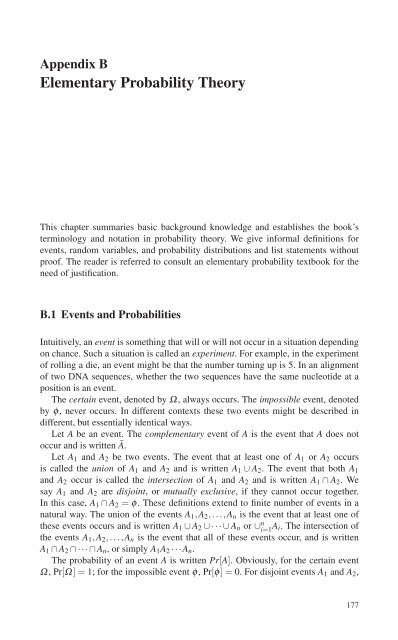Create successful ePaper yourself
Turn your PDF publications into a flip-book with our unique Google optimized e-Paper software.
Appendix B<br />
Elementary Probability Theory<br />
This chapter summaries basic background knowledge and establishes the book’s<br />
terminology and notation in probability theory. We give informal definitions for<br />
events, random variables, and probability distributions and list statements without<br />
proof. The reader is referred to consult an elementary probability textbook for the<br />
need of justification.<br />
B.1 Events and Probabilities<br />
Intuitively, an event is something that will or will not occur in a situation depending<br />
on chance. Such a situation is called an experiment. For example, in the experiment<br />
of rolling a die, an event might be that the number turning up is 5. In an alignment<br />
of two DNA sequences, whether the two sequences have the same nucleotide at a<br />
position is an event.<br />
The certain event, denoted by Ω, always occurs. The impossible event, denoted<br />
by φ, never occurs. In different contexts these two events might be described in<br />
different, but essentially identical ways.<br />
Let A be an event. The complementary event of A is the event that A does not<br />
occur and is written Ā.<br />
Let A 1 and A 2 be two events. The event that at least one of A 1 or A 2 occurs<br />
is called the union of A 1 and A 2 and is written A 1 ∪ A 2 . The event that both A 1<br />
and A 2 occur is called the intersection of A 1 and A 2 and is written A 1 ∩ A 2 .We<br />
say A 1 and A 2 are disjoint, ormutually exclusive, if they cannot occur together.<br />
In this case, A 1 ∩ A 2 = φ. These definitions extend to finite number of events in a<br />
natural way. The union of the events A 1 ,A 2 ,...,A n is the event that at least one of<br />
these events occurs and is written A 1 ∪ A 2 ∪···∪A n or ∪ n i=1 A i. The intersection of<br />
the events A 1 ,A 2 ,...,A n is the event that all of these events occur, and is written<br />
A 1 ∩ A 2 ∩···∩A n ,orsimplyA 1 A 2 ···A n .<br />
The probability of an event A is written Pr[A]. Obviously, for the certain event<br />
Ω, Pr[Ω]=1; for the impossible event φ, Pr[φ]=0. For disjoint events A 1 and A 2 ,<br />
177

















